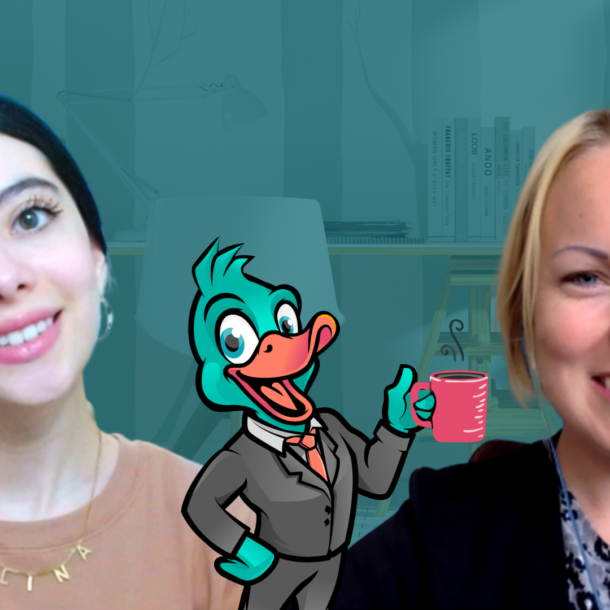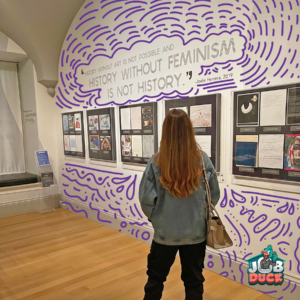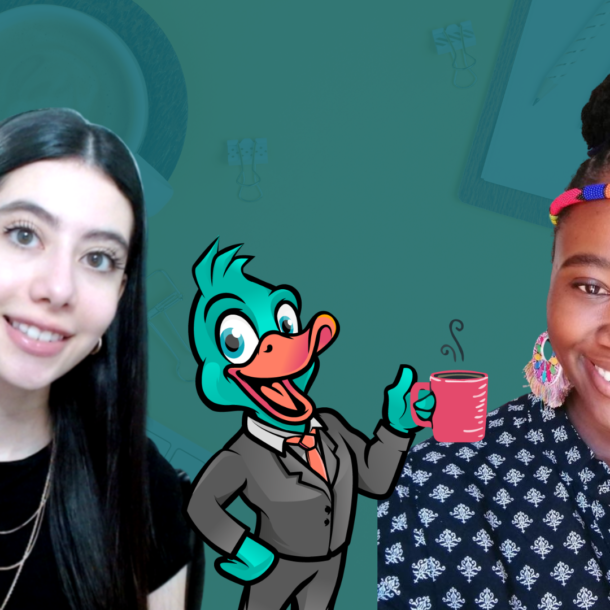
By guest writer Teresa Ramirez
“History without art is not possible and history without feminism is not history.”
– Jodie Herrera, 2019

Every year, as the International Women’s Day gets closer, my anxiety starts to arise — “do I have to set up my profile picture in purple”, “do I have to share feminist posts?”, “am I less of a feminist if I don’t go to the strike?”, “Today, more than ever, I have to prove that I’m a feminist, right?”. The answer is no. If you can relate to this, trust me, you’re not alone, and no one is judging us for this.
Call it a coincidence (and I will call it serendipity), but last week, I came across this picture of me on my camera roll. It helped me to remember what this day is really about.
“Donald W. Reynolds Center for American Art and Portraiture.
Exhibition: What is feminist art?” in D.C.
Today is about commemorating a fight that is not over
In the early 1900s, Women’s Day started to be recognized in many countries around the world. In 1975, during the International Women’s Year, the United Nations (UN) began proclaiming March 8 as International Women’s Day. Since then, every year we commemorate the fight for women’s rights and gender equality that millions of women have led throughout history. It is a day for collective reflection that seeks to eradicate the inequalities and barriers that still persist and prevent the full development of girls and women around the world. We’ve come really far in the last 100 years, but there’s still a long way to go. No country has achieved full gender equality.
This day means different things to different people, but the global focus on equality, participation, and empowerment of women in all areas of society is clear. Thus, commemorating this day doesn’t mean that we think that women deserve special rights; it means we know we deserve the same. Defending equality does not imply belittling or punishing men. Feminism does not speak of superiority or discrimination against the other gender, it simply combats the inequalities suffered by women for the fact of being women. We don’t fight to be “more”; we fight to be equal.
Today is not about saying “congratulations on being a woman” or giving away presents or flowers. Today is about educating ourselves and educating others, especially our children, about equality and respect.
What can I do to help?
Today is a day to claim women’s rights to make the cause visible. Today is about deconstructing and re-educating, especially on the actions we can all take to achieve gender equality. In case you want to know how to help, here are twelve ideas from the UN:
- Share the care: Commit to evenly sharing household chores, parenting responsibilities, and other unpaid work.
- Call out sexism and harassment.
- Reject the binary: It’s humankind, not mankind.
- Demand an equal work culture.
- Exercise your political rights: As of 2020, women only hold around 25% of seats in national parliaments and account for less than 7 percent of the world’s leaders. Let’s make it possible for more qualified women to achieve political opportunities. And vote, vote, vote!
- Shop responsibly: Pick up eco-friendly products, and reduce, reuse, and recycle.
- Amplify feminist books, movies, and more.
- Teach girls their worth.
- Challenge what it means to “be a man”: Expressions like “boys will be boys” often discourage boys and men later in life from openly communicating their feelings.
- Commit to a cause.
- Challenge beauty standards.
- Respect the choices of others.
2022 Women’s Day theme
The theme for this year is “Gender equality today for a sustainable tomorrow,”: calling for climate action for women, by women. Climate change represents one of the most controversial global challenges of the 21st century, with a serious impact on the economic, social, and environmental development of nations. Considering that across the world, women depend more on – yet have less access to – natural resources and often bear a disproportionate responsibility for securing food, water, and fuel, it is intended to recognize the valuable contribution of girls and women in mitigating and adapting to climate change worldwide. This will achieve a more sustainable future for everyone.
Why is Job Duck a great workplace for women?
Job Duck is a virtual staffing company that hires virtual assistants. Employees work from their homes once we match them to a single U.S.-based business.
- They hire based on their core values and work every day to live by them and preach with the example to keep an incredible work culture alive.
- They choose their clients based on the core values, too.
- Everyone gets the same salary and benefits, and they have standard policies in place for salary raises.
- Growth opportunities are based on performance, not on gender (the leadership team is equally formed by women and men.)
- By working from home and with a fixed schedule, it’s easier to share home responsibilities with your family, roomies, or partner.
- Breaks and lunch breaks are respected, and everyone gets a fair amount of paid days off — sick leaves, emergency leaves, and vacation leaves.
- They respect everyone’s beliefs, preferences, culture, race, and gender.
As a woman working with Job Duck for three years, remotely, I’m glad — and I feel grateful and blessed every day — that I found a safe workplace where my worth is acknowledged. It’s a virtual job, no one judges your looks or what you’re wearing, yet I’m positive that if this was a non-virtual space, that wouldn’t change. I’ve never been harassed or suffered any kind of gender discrimination. Everyone is respectful and helpful. I’ve been given amazing growth opportunities within the company because of my performance.
If you want to work from home, are bilingual, own a personal laptop, and have good internet speed, apply to one of our career growth opportunities HERE.
Disclaimer: This blog entry presented on Jobduck.com and the opinions expressed are those of the author and do not necessarily reflect those of Job Duck.



